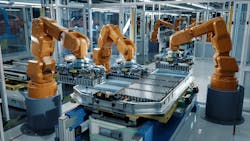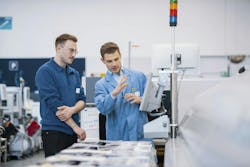In this exclusive interview with Automation World, Annemarie Breu, senior director of automation software deployment and incubation at Siemens AG, reveals how AI, edge computing and real-time optimization are being used to build resilient adaptive production systems that continuously improve themselves.
AW: Explain the concept of “adaptive production” — what it means in terms of changes to traditional manufacturing production operations, which type and size of manufacturing operation it typically applies to and why it’s considered necessary.
Adaptive production represents a shift from traditional, efficiency-focused manufacturing to systems that are intelligent, responsive and resilient. Rather than optimizing for scale alone, adaptive production enables real-time reactions to disruptions in demand, supply or operations — such as shifts in consumer behavior, geopolitical events or pandemics.
By leveraging AI, predictive analytics and automation, adaptive systems dynamically optimize production and resource allocation. Crucially, they don’t replace workers but support them by tailoring systems to operators, engineers and managers. This approach applies across all manufacturing scales, from small businesses to global enterprises, using plug-and-play technologies that reduce the need for specialized technical skills.
AW: How does “adaptive production” differ from “flexible manufacturing,” a term that has been used for years to describe a production system designed to adapt to changes in the type and quantity of the product(s) being produced?
While flexible manufacturing focuses on switching between product types — especially in high-mix, low-volume environments — adaptive production goes further. It doesn’t just respond to product variation, but to the entire spectrum of process conditions, including equipment behavior, environmental factors and supply inconsistencies.
Adaptive systems continuously monitor performance, detect quality deviations, trace root causes and adjust parameters in real time to prevent future issues. This makes them suitable for any production mix or volume and central to long-term improvement in yield, quality and throughput.
AW: What are the key technologies needed to enable adaptive production?
Adaptive production is powered by a layered tech stack that builds on existing infrastructure, especially in brownfield environments. At the core of this stack is edge computing, which processes data close to machines for real-time functions like visual inspection, anomaly detection and predictive maintenance.
Data integration is equally critical. Information from control systems, ERP software, quality databases and staffing schedules must be unified and contextualized. Graph databases, which connect the data they store to relevant network nodes and edges, make this possible by mapping relationships between machines, sensors and processes to create a coherent model of the production environment. This enables the data to be linked together and retrieved more easily.
Once data is modeled, generative AI and large language models unlock accessibility. Users can ask plain-language questions about performance or problems, receiving actionable, data-driven answers without needing to navigate complex systems.
AW: How do these technologies deliver on the interconnected feedback and optimization cycle that enable the continuous adaptation and improvement that is key to adaptive production?
These technologies form a closed feedback loop — from sensing to analysis to action. Edge devices collect and process real-time data, identifying deviations in quality or performance. This data is contextualized through graph-based models, enabling in-depth root cause analysis.
With this insight, generative AI can answer operational questions in natural language to bridge the gap between technical complexity and user intuition. When appropriate, corrective actions, such as parameter adjustments, are automatically sent back to the control layer, completing the loop.
This system allows manufacturers to quickly react to issues and continuously improve processes to make operations smarter, more efficient and more resilient.
AW: What is the recommendation for brownfield manufacturing sites that already have production equipment and processes in place to enable an efficient and effective move toward adaptive production?
For brownfield environments, the goal isn’t replacement, but augmentation. Adaptive production begins by layering edge computing onto existing systems, using protocol connectors to access data from various vendors and legacy equipment.
Manufacturers can add low-cost, intelligent sensors, such as cameras, microphones and environmental monitors, to collect additional insights. These data points, which are often stored in diverse formats, must be harmonized through efficient modeling and semantic mapping to build a unified, meaningful representation of the production environment. This can be done with the use of graph databases, as I noted earlier.
This scalable approach enables gradual adoption of adaptive capabilities, like AI-driven monitoring, root cause analysis and self-optimization, without disrupting day-to-day operations or requiring a full infrastructure overhaul.
AW: Can you highlight any companies who have made this move already — how they did it and what the benefits have been so far?
Yes. Tyson Foods is a strong example. They’ve embedded AI copilots directly into daily operations, where the systems assist in shift planning and decision-making by drawing on years of historical data. Because the AI fits naturally into existing workflows, adoption has been high and minimal change management has been necessary.
Across the successful implementations we’ve done for adaptive production, two themes stand out: the need for strong data foundations and user-centered design. Companies that invest in data modeling and contextualization to clearly define relationships between machines, sensors and lines can unlock the full value of advanced AI tools.
We’ve also seen that these adaptive systems work best when designed with frontline users in mind. By involving machine operators, plant managers and maintenance staff early in the process, companies ensure usability and adoption. This is critical because these systems don’t replace people, they capture their know-how to support better decision-making by human engineers and operators and reduce manual troubleshooting.
The impact is both operational and cultural. With the implementation of adaptive production, we’ve seen better performance metrics related to yield, quality and uptime, as well as faster problem resolution and more engaging, tech-supported work environments. These last two points are critical to successfully addressing the manufacturing workforce gap.


